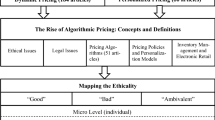Conclusions
Our purpose in undertaking this investigation was two-fold. First, we sought to examine the divergence between regulatory policy in practice and prescription from economic theory. Second, we wished to determine whether by facilitating entry into unregulated market. We found a close connection between these two apparently disparate issues.
Our conclusion is that a regulator may be able to enhance the level of expected consumers' surplus generated in a regulated market by allowing the regulated firm to enter unregulated markets. We have associated “entry” into unregulated markets with the possession of “capital” that constitutes a critical factor of production in the unregulated market. The key feature of this capital is that its value is positively correlated with production costs in the regulated industry. Consequently, if the firm attempts to exaggerate its costs of producing in the regulated market, it simultaneously exaggerates the profits it will earn in the unregulated sector. enabling the regulator to reduced the allowed compensation in the regulated sector. In effect, allowing entry into unregulated markets introduces a counteravailing incentive for the firm which limits its tendency to exaggerate production costs. This enables the regulator to better control the profits earned by the regulated firm. This is the case even when: (i) ratepayers in the regulated industry provide the initial funding for the firm's venture into the unregulated market; and (ii) the capacity afforded the firm cannot be used to produce in the regulated sector.
The presence of countervailing incentives gives rise to “stickness” in optimal regulated prices. To limit the incentive to exaggerate low cost realizations, prices are set in excess of realized marginal cost. To mitigate the tendency t understate high realizations of c (and thereby undersate earnings in the unregulated sector), prices are set below realized marginal cost. For a wide range of intermediate cost realizations, these countervailing incentives result in a single regulated price being optimal. Thus, the optimal policy here is more congruent with a regulatory policy in a practice; a simple pricing rule is instituted rather than a complex pricing formula that affords considerable discretion to the firm.
In a closing, we wish to emphasize that our model is designed to examine only certain elements of the decision to permit regulated firms to enter unregulated markets. In practice, there are many other elements that warrant caregul consideration. For example, there may be concern that the regulated firm will have an “unfair” competitive advantage in unregulated markets. Alternatively, entry into unregulated markets may complicate cost accounting procedures and thereby facilitate undesired cross subsidies. Furthermore, the possibility exists that a regulated firm might allow the quality of the regulated service to deteriorate when its attention is focused in other markets. These issues await additional research.
Similar content being viewed by others
References
Baron, D., and D. Besanko. 1984. “Regulation and Information in a Continuing Relationship”. Information Economics and Policy 1:267–302.
Baron, D., and R. Myerson. 1982. “Regulating a Monopolist with Unknown Costs”. Econometrica 50:911–930.
Lewis, T., and D. Sappington. 1989a. “Countervailing Incentives in Agency Problems”. Journal of Economic Theory (forthcoming).
Lewis, T., and D. Sappington. 1989b. “Inflexible Rules in Incentive Problems”. American Economic Review 79 (forthcoming).
Sappington, D. 1983. “Optimal Regulation of a Multiproduct Firm with Unknown Technological Capabilities”. Bell Journal of Economics 14:453–463.
Author information
Authors and Affiliations
Rights and permissions
About this article
Cite this article
Lewis, T.R., Sappington, D.E.M. An informational effect when regulated firms enter unregulated markets. J Regul Econ 1, 35–45 (1989). https://doi.org/10.1007/BF00150296
Issue Date:
DOI: https://doi.org/10.1007/BF00150296



